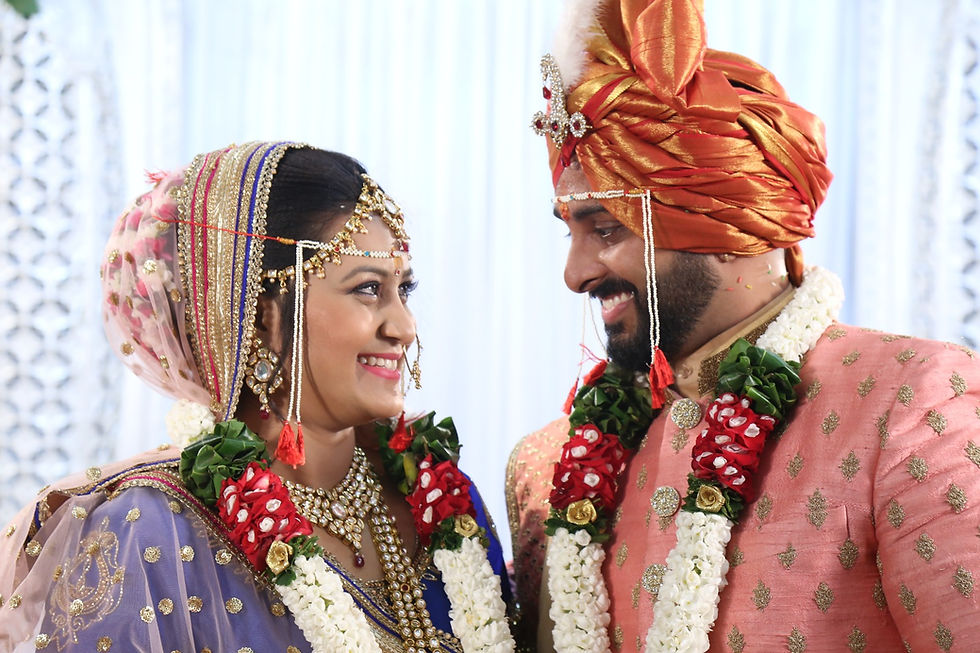Mangalashtak Meets the Thalikettu
- Sumana Mukherjee
- 6 days ago
- 4 min read

A friend once told me inter-state weddings in India are the finest cultural exchange programs. Having been fortunate to attend wedding ceremonies spanning multiple cultures across the country, I couldn’t agree more. Meenakshi and Thujesh—a modern conscious Indian couple—brought together the rich traditions from their native lands of Maharashtra and Kerala to begin a lifelong journey.
Sumana: Did you follow specific cultural rituals during your wedding?
Meenakshi & Thujesh : We wanted to honour both our Maharashtrian and Malayali traditions at our wedding while keeping it intimate and meaningful. We planned it in a way that kept the core rituals intact but didn’t extend the wedding period for too long. For instance, Meenakshi adores the Marathi ritual of Mangalashtak. And so we decided that for the Marathi rituals, we will have a simple version of the Puja followed by a proper Mangalashtak ceremony. We then moved to the Pheras and had the Kerala style wedding with a change of attire, as is typical in the Malayali culture. We had the Dakshina giving ceremony to the parents and then the Thalikettu, which is the tying of the Mangalsutra with the Pheras. We kept it short and sweet, highlighting the most important rituals of both our cultures in the wedding.
Sumana : Being a designer yourself Meenakshi, how did you envision and bring to life your dream wedding outfit?
Meenakshi : We had two central wedding outfits. My personal favourite is the one I wore for the Maharashtrian rituals, especially because it was the first ritual we went with. I wore a bridal lehenga. Traditionally in Maharashtrian weddings the bride wears a sari or a Navari, which usually is a Paithani or a Kathpadarachi sari. They are usually handwoven with rich borders. But having designed lehengas for many brides earlier, I decided to go with a special lehenga with dupatta for myself too, while Thujesh wore an embellished sherwani for our Maharashtrian wedding.
This lehenga is really close to my heart because I believe a bride should feel their best on the wedding day. I decided to take it on as a challenge to bring that meaning of the special day to my outfit. I handpainted my own lehenga and designed all the motifs myself. The handpaintings were portraits of me and my husband on alternate panels in small frames. Then it was hand embroidered with Katdana and stones, with a beautiful Zardozi border. I wanted my lehenga to be elegant and graceful so I chose shades of light pink with hints of red and royal blue with peacock and flower motifs. I also designed a pure silk sherwani in onion pink for Thujesh which he paired with a shawl and a beautiful Pheta. Adorning his Pheta was an ornamented Kalgi, the crown jewel of Indian turbans commonly worn by grooms in Northern India. I love the tradition of wearing the Mundawala, which is a pearl string tied on the forehead, a mandatory Maharashtrian accessory for both the bride and the groom.

Our Kerala style wedding is a beautiful memory. Saris are the traditional bridal wear in Malayali culture and so I wore a lovely turquoise hand-woven Banarasi silk sari, which had a magenta border. And I accessorised with a Nath, which is a signature Marathi nose pin. I wore this for the pheras and then changed into an authentic handwoven Kanjivaram sari that was gifted to me by my new family, a blessing that holds a special place in my life. It was a moment that I will always remember, a Marathi woman beginning a life in a Malayali family. My husband wore a handwoven magenta silk kurta with a Mundu to respect that moment.

Sumana : How important do you think it is for brides and grooms to include ethnic artisanal textiles in their wedding trousseau?
Meenakshi : Thank you for asking this question because I feel it's very important that both brides and grooms choose their wedding outfits consciously and ethically. Artisanal textiles carry a lot of cultural importance beyond being beautiful fabrics. They are carrying our legacy and our Indian roots that connect us all. They become the stories for the future generations. Especially for wedding outfits, since they are cherished for lifetimes and get passed on to the next generations. Including Indian artisanal textiles and handlooms only enrich these memories for the entire family. These are absolutely unique pieces, so why not choose handmade and handwoven garments for our most special day? No two handmade pieces can ever be similar, there are artisans who spend hours and weeks making them for us, pouring their heart and soul into every piece so it stays memorable. This can never match something which is mass-produced. Choosing artisan-made garments also means you are voting for a more conscious and ethical society. And the most wonderful thing about handlooms and handmade textiles is that they are sustainable. The way the landfills are filling up with waste, it’s about time we start being mindful of the climate crisis that fast fashion has brought along. So the least one can do for a wedding day is to choose artisanal wear, it’s a beautiful and conscious choice.

What’s a human if they can’t spare a minute to think about the rest of the human community? As Meenakshi and Thujesh continue to live their lives being kind to both the environment and the people around them, we hope a lot more urban Indian couples align with their vision of conscious living.
Meenakshi also runs Jamuni Design—a handmade, artisanal and sustainable label that makes beautiful journals to capture our lives with meaning.
Support our work on documenting Indian textile heritage—Buy our previous editions!




Comments